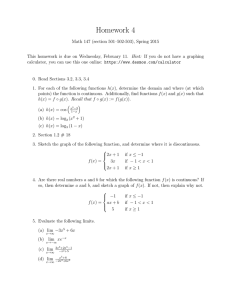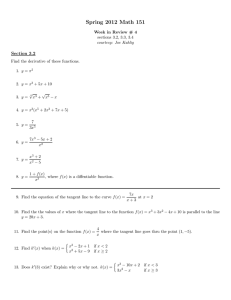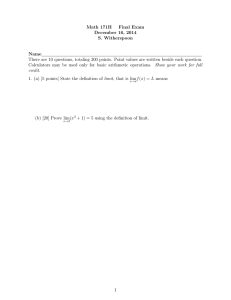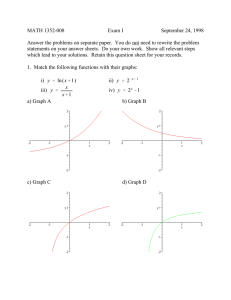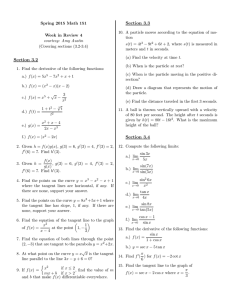Calculus
advertisement
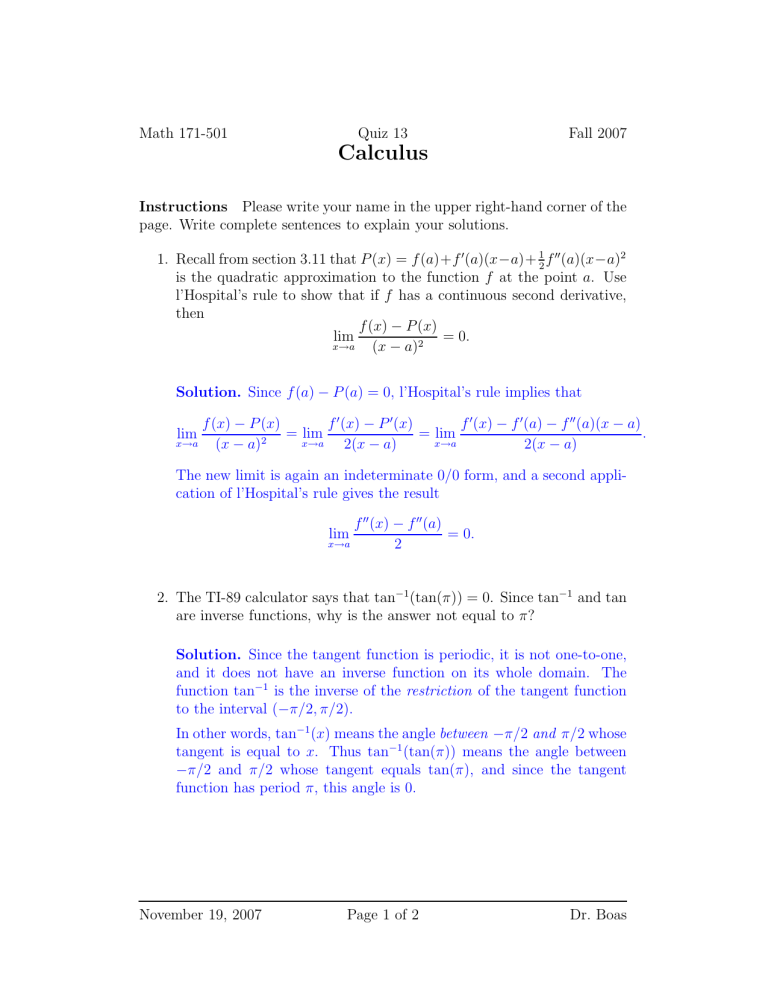
Math 171-501 Quiz 13 Fall 2007 Calculus Instructions Please write your name in the upper right-hand corner of the page. Write complete sentences to explain your solutions. 1. Recall from section 3.11 that P (x) = f (a)+f ′ (a)(x−a)+ 12 f ′′ (a)(x−a)2 is the quadratic approximation to the function f at the point a. Use l’Hospital’s rule to show that if f has a continuous second derivative, then f (x) − P (x) lim = 0. x→a (x − a)2 Solution. Since f (a) − P (a) = 0, l’Hospital’s rule implies that f ′ (x) − P ′ (x) f ′ (x) − f ′ (a) − f ′′ (a)(x − a) f (x) − P (x) = lim = lim . x→a x→a x→a (x − a)2 2(x − a) 2(x − a) lim The new limit is again an indeterminate 0/0 form, and a second application of l’Hospital’s rule gives the result f ′′ (x) − f ′′ (a) = 0. x→a 2 lim 2. The TI-89 calculator says that tan−1 (tan(π)) = 0. Since tan−1 and tan are inverse functions, why is the answer not equal to π? Solution. Since the tangent function is periodic, it is not one-to-one, and it does not have an inverse function on its whole domain. The function tan−1 is the inverse of the restriction of the tangent function to the interval (−π/2, π/2). In other words, tan−1 (x) means the angle between −π/2 and π/2 whose tangent is equal to x. Thus tan−1 (tan(π)) means the angle between −π/2 and π/2 whose tangent equals tan(π), and since the tangent function has period π, this angle is 0. November 19, 2007 Page 1 of 2 Dr. Boas Math 171-501 Quiz 13 Fall 2007 Calculus 3. Show that sin2 (cos−1 (x)) = 1 − x2 when −1 ≤ x ≤ 1. [Remember that the two exponents have different meanings: the exponent −1 means inverse function, while the exponent 2 means the second power.] Solution. Method 1. Draw a right triangle having angle θ, hypotenuse equal to 1, and side adjacent to angle θ equal √ to x. Then −1 θ = cos (x). The third side of the triangle equals 1 − x2 by the Pythagorean theorem, but this third side also equals sin(θ). The quantity to be found is sin2 (θ), which therefore equals 1 − x2 . Method 2. Since sin2 (θ) = 1 − cos2 (θ) for every θ, we can write sin2 (cos−1 (x)) = 1 − cos2 (cos−1 (x)). Now cos2 (cos−1 (x)) means [cos(cos−1 (x))]2 , which simplifies to x2 because cos and cos−1 are inverse functions. Substituting back into the displayed formula gives the desired result 1 − x2 . 4. The TI-89 calculator says that lim (xe1/x − x) = 1. Prove this result. x→∞ e1/x − 1 . 1/x When x → ∞, we have an indeterminate 0/0 form, so l’Hospital’s rule equates the limit to Solution. Method 1. Write xe1/x − x = x(e1/x − 1) = e1/x (−1/x2 ) = lim e1/x = e0 = 1. 2 x→∞ x→∞ −1/x lim Method 2. Write x = 1/t. Then lim x(e1/x − 1) = lim+ x→∞ t→0 et − 1 , t and by l’Hospital’s rule, the new limit equals lim+ et = 1. t→0 November 19, 2007 Page 2 of 2 Dr. Boas

